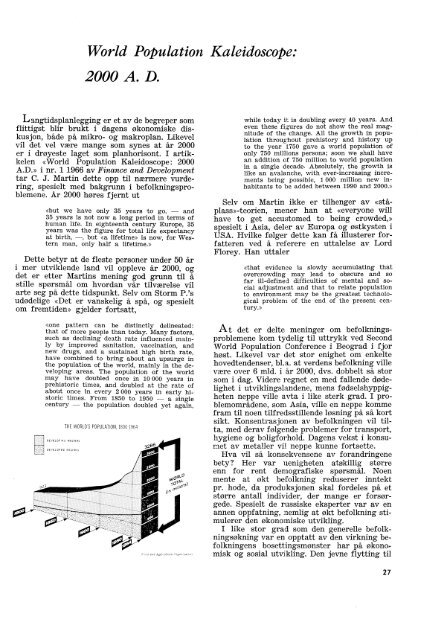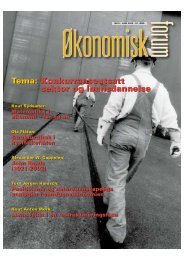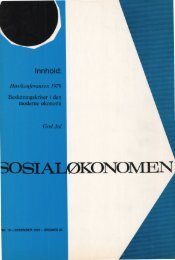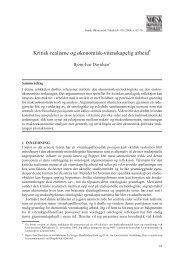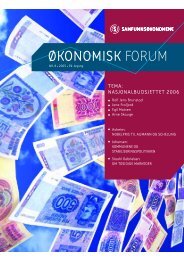stem en oppløsning <strong>av</strong> det tradisjonelle personlighetsgrunnlag.»Reklameinnsats bør <strong>av</strong>giftsbelegges strengt, for atvirksomheten kan begrenses. For en som selv er <strong>av</strong>hovedsakelig samme oppfatning på dette punkt somHaaland, er hans analyse <strong>av</strong> reklamemaskinerietsmiljøfordervende virkninger gefundenes Fressen.Dessverre skjemmes argumentverdien sterkt ved atreklameinnsats i bedriftene stadig omtales som«skattefritt forbruk» (i motsetning til virkelige produksjonsoppofringer),noe som bedriftsøkonomisksett vanskelig kan begrunnes. Det gjøres det daheller ikke forsøk på.Det blir slått fast at det allerede i dagens skatteogJ<strong>av</strong>giftssystem praktiseres mekanismer som har tilhensikt å virke oppmuntrende 'eller <strong>av</strong>skrekkende påvisse former for privat forbruk. Haaland ønsker enmer utstrakt bruk <strong>av</strong> ioppmuntrings- og <strong>av</strong>skrekningsmekanismenefor å fremme en kulturelt merønskelig forbrukssammensetning, «samfunnsnyttesom fritaksprinsipp». Han anbefaler fradragsrettved ligningen ved anskaffelse <strong>av</strong> bibliotek, teaterbesøk,studiereiser, kjøp <strong>av</strong> bildende kunst direktefra kunstner, 'donasjoner til statsautoriserte formål.Etter undertegnedes mening behandler Haala,ndher emner der vi vil få klare og dype skillelinjer ipolitikken i fremtiden. Problemene vil kreve standpunkttageni de konkrete saker, men enda mer fårvi behov for en politisk <strong>av</strong>klaring <strong>av</strong> de prinsipperen ønsker å legge til grunn. «Verdiplanlegging» erbetegnelsen forfatteren setter på denne del <strong>av</strong> politikken.Vi vil (igjen etter undertegnedes mening) troligse tydeligere enn i dag utvikling <strong>av</strong> én retning somrekrutteres fra de konservative og sosialistiske patriarkalskekretser, som foruten de generelle, mindremekanisk tvingende, miljømessige påvirkningsmidleri meget stor grad vil benytte seg <strong>av</strong> manipulasjon <strong>av</strong>de rent økonomiske vare- og tjenestepriser, samtforbud. På den annen s'ide vil det måtte skapes enretning basert på en modernisering <strong>av</strong> den liberalesamfunnsholdning. Også dens tilhengere må erkjennebehovet for en forming <strong>av</strong> samfunnet gjennom politiskebeslutninger. Men den vil måtte benekte etnasjonalforsamlingSflertalls uinnskrenkede kompetansepå kultur- og livssynområdet, og stille spørsmålstegnved det formålstjenlige og menneskeverdigei at Staten utstyrer den enkelte med hans ferdigpakkede«vare- og tjenestekurv». Haaland står meden fot i hver leir.Dessverre har Haaland ikke begrenset seg til å beskrivevårt skattesystems merkverdige følger og ådrøfte de prinsipielle sider ved samfunnets påvirkningssystemog forbrukssammensetningen.iStore deler <strong>av</strong> boken går med til løsning <strong>av</strong> inflasjonsproblemet,problemet med de store kapitalgevinstergjennom verdistigning på fast eiendom, ogemnet ,samfunnsmessig sparing. Også de mer prinsipiellekapitler er spekket med fag-økonomiske betraktninger.Det aller meste <strong>av</strong> stoffet om disse emnerer direkte galt og/eller villedende. I disse spaltermå det være på sin plass å advare ikke-økonomermot å lese, med tanke på å akseptere, bokens rentsosialøkonomiske fremstillinger. (Men dette stoffetbør egne seg til analyse i semesteroppg<strong>av</strong>er i Teoretiskøkonomi og Penge- og Finanslære.)Her skal bare trekkes frem et par eksempler, noen.fullstendig imøtegåelse er det selvsagt ikke anledflingtil :«Med nyinvesteringer på ca. en tredjedel <strong>av</strong> nasjonalproduktet,må der ett eller annet sted skje enenorm oppsparing». (Bruttoinvesteringene utgjør 1/3<strong>av</strong> bruttonasjonalproduktet).Haaland trekker bl. a. importoverskuddet fra nasjonalproduktetfor å komme frem til anslag overinntekt som bør beskattes.Inflasjonen kureres ved at lønnstagerne i stedetfor mer penger får lånebevis «med sikkerhet i detsamlede næringsliv.» Motverdien er oppstått gjennomhardere beskatning <strong>av</strong> en del <strong>av</strong> næringslivet,--.ien slik at disse beløp ikke er innbetalt til det offentlige,men utgjør en fordring det offentlige har på,bedriftene. Denne fordringsmassen danner grunnlagetfor et offentlig «Investeringsfond», der dessuten.overskudd på statsbudsjettet skal inngå. Lånebevisenekan først veksles i penger om 10 år, men skalkunne brukes til <strong>av</strong>betaling på f. eks. boliggjeld.Det kan bare fastslås at 'bokføringens magiskeegenskaper står urokket. Til Haalands forsvar kandog anføres at ordningen har likhetspunkter medLov om skattefrie fonds<strong>av</strong>setninger.Hvor nyttige og nødvendige de nitide og ofte tørreresonnementene i det sosialøkonomiske studiet er,gir slik lesning et godt inntrykk ay. ,Og blundere somHaalands er jo sørgelig utbredt. Likevel melderspørs målet seg om ikke en latterliggjørelse <strong>av</strong> vårtskattesystem, i den grad den er vellykket, også eren anklage mot sosialøkonomene som yrkesgruppe.Formelt ligger selvsagt ansvaret hos Stortinget.Men man kan åpenbart ikke vente tidsmessige initiativfra en nasjonalforsamling der en vesentlig del<strong>av</strong> medlemmene erklærer at de føler seg unyttige nårde ikke holdes i ånde <strong>av</strong> Regjeringen gjennom enstadig flom <strong>av</strong> løpende saker.I folkeopplysningen og opinionsdannelsen har sosialøkonomenevært påfallende tilbakeholdne. Detskulle ikke være noen fare for at sosialøkonomerbare ser de «rent økonomiske» sider ved f. eks. skattepolitikken.Enhver som har vært gjennom detvelferdsteoretiske pensum i ‘Frederiksgate har kon-.troll over hvor faget slutter Dg vurderingene begynner,og er så kompetent til å ha meninger somnoen.Arild Haaland har kastet en hanske som bør tasopp <strong>av</strong> mange sosialøkonomer. Lønn, Skatt og DetGode Liv blir den naturlige apéritif til den skattedebattsom må følge den nye skattekomitéens innstilling.Kristen Knudsen.26
World Population Kaleidoscope:2000 A. D.angtidsplanlegging er et <strong>av</strong> de begreper somflittigst blir brukt i dagens økonomiske diskusjon,både på mikro- og makroplan. Likevelvil det vel være mange som synes at år 2000er i drøyeste laget som planhorisont. I artikkelen«World Population Kaleidoscope: 2000A.D.» i nr. 1 1966 <strong>av</strong> Finance and Developmenttar C. J. Martin dette opp til nærmere vurdering,spesielt med bakgrunn i befolkningsproblemene.År 2000 høres fjernt ut«but we h<strong>av</strong>e only 35 years to go, - and35 years is not now a long period in terms ofhuman life. In eighteenth century Europe, 35years was the figure for total life expectancyat birth, -, but «a lifetime» is now, for Westernman, only half a lifetime.»Dette betyr at de fleste personer under 50 åri mer utviklende land vil oppleve år 2000, ogdet er etter Martins mening god grunn til åstille spørsmål om hvordan vår tilværelse vilarte seg på dette tidspunkt. Selv om Storm P.'sudødelige «Det er vanskelig å spå, og spesieltom fremtiden» gjelder fortsatt,«one pattern can be distinctly delineated:that of more people than today. Many factors,such as declining death rate influenced mainlyby improved sanitation, vaccination, andnew drugs, and a sustained high birth rate,h<strong>av</strong>e combined to bring about an upsurge inthe population of the world, mainly in the developingareas. The population of the worldmay h<strong>av</strong>e doubled once in 10 000 years inprehistoric times, and doubled at the rate ofabout once in every 2 000 years in early historictimes. From 1850 to 1950 - a singlecentury - the population doubled yet again,THE WORLD'S POPULATION, 1800-1964Food and A,riculturc OrganizaHortwhile today it is doubling every 40 years. Andeven these figures do not show the real magnitudeof the change. All the growth in populationthroughout prehistory and history upto the year 1750 g<strong>av</strong>e a world population ofonly 750 millions persons; soon we shall h<strong>av</strong>ean addition of 750 million to world populationin a single decade. Absolutely, the growth islike an <strong>av</strong>alanche, with ever-increasing incrementsbeing possible, 1 000 million new inhabitantsto be added 'between 1990 and 2000.»Selv om Martin ikke er tilhenger <strong>av</strong> «ståplass»-teorien,mener han at «everyone willh<strong>av</strong>e to get accustomed to being crowded,»spesielt i Asia, deler <strong>av</strong> Europa og østkysten iUSA. Hvilke følger dette kan få illusterer forfatterenved å referere en uttalelse <strong>av</strong> LordFlorey. Han uttaler«that evidence is slowly accumulating thatovercrowding may lead to obscure and sofar ill-defined difficulties of mental and socialadjustment and that to relate populationto environment may be the greatest technologicalproblem of the end of the present century.»At det er delte meninger om befolkningsproblemenekom ty delig til uttrykk ved SecondWorld Population Conference i Beograd i fjorhøst. Likevel var det stor enighet om enkeltehovedtendenser, bl.a. at verdens befolkning villevære over 6 mld. i hr 2000, dvs. dobbelt så storsom i dag. Videre regnet en med fallende dødeligheti utviklingslandene, mens fødselshyppighetenneppe ville <strong>av</strong>ta i like sterk grad. I problemområdene,som Asia, ville en neppe kommefram til noen tilfredsstillende løsning på så kortsikt. Konsentrasjonen <strong>av</strong> befolkningen vil tilta,med der<strong>av</strong> folgende problemer for transport,hygiene og boligforhold. Dagens vekst i konsumet<strong>av</strong> metaller vil neppe kunne fortsette.Hva vil så konsekvensene <strong>av</strong> forandringenebety ? Her var uenigheten atskillig størreenn for rent demografiske spørsmål. Noenmente at okt befolkning reduserer inntektpr. hode, da produksjonen skal fordeles på etstørre antall individer, der mange er forsørgede.Spesielt de russiske eksperter var <strong>av</strong> enannen oppfatning, nemlig at økt befolkning stimulererden økonomiske utvikling.I like stor grad som den generelle befolkningsøkningvar en opptatt <strong>av</strong> den virkning befolkningensbosettingsmønster har på økonormisk og sosial utvikling. Den jevne flytting til27


